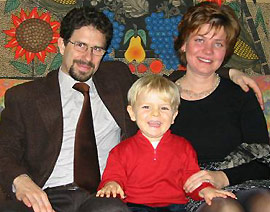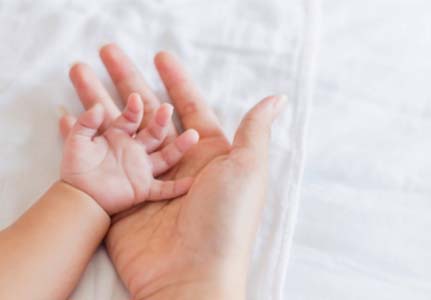Ichthyosis – Flavio Minelli


‘My wife and I knew that my father-in-law suffered from ichthyosis, but we didn’t associate it with a genetic condition,’ says Flavio Minelli, member of the Board of Eurordis. ‘My wife had an amniotic fluid test, and doctors asked us about genetic disease history in our families, but we never thought of mentioning ichthyosis! If only we had known…’ Flavio’s father-in-law has recessive [X-linked ichthyosis->http://www.orpha.net/consor/cgi-bin/OC_Exp.php?Lng=GB&Expert=461], so he transmitted it to his daughter, who doesn’t suffer from the disease but transmitted it in turn to her first son, Valerio. Most women who bear a child with the disease have problems at delivery. The problem is linked to a deficit of steroid sulphatase in the baby, an enzyme playing a role in the cholesterol degradation chain. ‘Contractions didn’t start when the baby was due, so my wife was monitored closely,’ says Flavio. ‘She called me to say they had decided to induce labour. I was ready to go to hospital when she called me back and said the baby’s heart had stopped beating and she was being taken to the surgical room!’ The doctors performed a caesarean in less than three minutes. The baby was reanimated and ventilated because he wasn’t breathing at first. Doctors told Flavio they had to wait to see if there was going to be any permanent damages to his son’s organs. Valerio was closely monitored for two weeks; the doctors looked for brain, heart or kidney complications due to the lack of oxygen, but found nothing. ‘They said it was an accident, and that there was no identifiable reason for what had happened,’ says Flavio.
‘The first thing my brother-in-law said when he saw Valerio was, “We are lucky. He didn’t inherit Dad’s ichthyosis!”’ It is only after hearing these words that Flavio realised there was more to it than what the doctors had said, and he searched the Net for information. He then knew nothing about rare diseases. He found an informal support group for patients and parents of children with ichthyosis and contacted them. After explaining what had happened, the group coordinator told Flavio that Valerio probably had recessive X-linked ichthyosis. ‘Doctors did more tests on my son for a few months to find out if he suffered from consequences of the lack of oxygen. They never tried to find out why this happened in the first place!’ Six months later, Valerio was declared ‘totally fine’ by the doctors and they said to stop worrying. ‘We were so relieved,’ says Flavio.
He and his wife continued searching the Internet for information about the disease. They found sites for medical practitioners and specialists such as the [OMIM->http://www3.ncbi.nlm.nih.gov/entrez/query.fcgi?db=OMIM] catalogue of human genes and genetic disorders (Online Mendelian Inheritance in Man). They were lucky because a month after Valerio’s birth, the ichthyosis support group had a meeting at a clinic dedicated to researching and curing dermatologic diseases in Rome. There they met a doctor that listened to them, at last. He confirmed that Valerio suffered from a mild case of ichthyosis. He has dry skin and scales on the front of his legs as well as on his scalp. ‘We bathe him and treat him with creams to make sure the skin stays hydrated,’ says Flavio. ‘There is no cure for ichthyosis, and the medical treatments available are only for the more severe cases of ichthyosis.’ Did Flavio and his wife’s experience stop them from having another child? Not at all! ‘By then we knew enough about the disease to make the decision to have another child with the same condition. We avoided the delivery drama by inducing labour two weeks before term. Our second son Lorenzo was born without ichthyosis.’
In 2002, Flavio became the coordinator of the group of people who had helped them. In March 2003, they started their own association, UNITI (Italian Union for Ichthyosis), to focus on helping people affected by any kind of disease having ichthyosis as main or secondary symptom. Because they needed help and advice from a more experienced organisation, UNITI joined UNIAMO (Italian Federation for Rare Diseases). Flavio became more involved in UNIAMO’s activities, and at their 2003 General Assembly, he was elected to the Board and became Vice-President. From UNIAMO, it was only a natural step to Eurordis. Flavio was elected to its board in 2005. Today, Flavio is not a member of UNIAMO’s board anymore, but he still represents the organisation in its international activities.
What’s driving him? ‘My involvement now stems from a desire to do something for all people affected by rare diseases in Europe and possibly to help them avoid the agony of self reproach and worry we’ve gone through. Fast, accurate and empathic information, from a patient’s point of view, is too important to leave it to professionals.’ That’s why he has agreed to be the list owner for the ichthyosis mailing list that Eurordis is currently implementing in order to facilitate the exchange of information and reduce the isolation of people living with rare diseases in Europe. If you are interested in the ichthyosis Internet patient community, please visit [http://eurordis.medicalistes.org->http://eurordis.medicalistes.org/rubrique4.html]. If you wish to create a list for your particular disease, you can email us at eurordis-list@eurordis.org.
–
This article was previously published in the February 2006 issue of our newsletter.
Author: Jerome Parisse-Brassens
Photos : © Flavio Minelli

